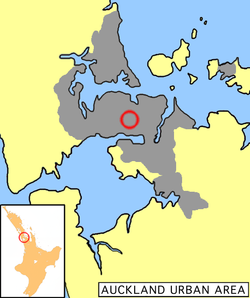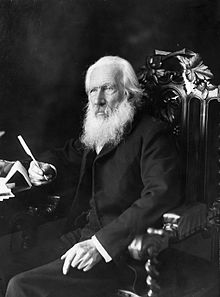
Abel Tasman National Park is a national park at the north end of New Zealand's South Island. It covers 237.1 km2 (91.5 sq mi) of land between Golden Bay / Mohua and Tasman Bay / Te Tai-o-Aorere, making it the smallest of New Zealand's national parks. Despite this, the park is one of the most visited, partially due to the popularity of the Abel Tasman Coast Track which spans 60 km (37 mi) along the eastern and northern coastal areas of the park.
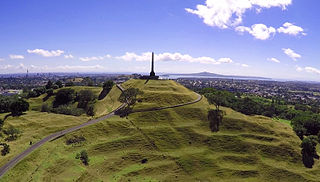
Maungakiekie / One Tree Hill is a 182-metre (597 ft) volcanic peak and Tūpuna Maunga in Auckland, New Zealand. It is an important place culturally and archeologically for both Māori and Pākehā. The suburb around the base of the hill is also called One Tree Hill. It is surrounded by the suburbs of Royal Oak to the west, and clockwise, Epsom, Greenlane, Oranga, and Onehunga. The summit provides views across the Auckland area, and allows visitors to see both of Auckland's harbours.

Epsom is a suburb of Auckland, New Zealand. It is located in the centre of the Auckland isthmus between Mount Eden and Greenlane, south of Newmarket, and 5 km (3.1 mi) south of the Auckland City Centre.

Sir John Logan Campbell was a Scottish-born New Zealand public figure. He was described by his contemporaries as "the father of Auckland".

Remuera is an affluent suburb in Auckland, New Zealand. It is located four kilometres southeast of the city centre. Remuera is characterised by many large houses, often Edwardian or mid 20th century. A prime example of a "leafy" suburb, Remuera is noted for its quiet tree lined streets. The suburb has numerous green spaces, most obvious of which is Ōhinerau / Mount Hobson – a volcanic cone with views from the top overlooking Waitematā Harbour and Rangitoto.

Greenlane railway station serves the Southern Line and Onehunga Line of the Auckland railway network. It was opened circa 1877. It has an island platform and is reached via a ramp from Green Lane East. It is the nearest station to Ellerslie Racecourse, Greenlane Clinical Centre, ASB Showgrounds and Cornwall Park.

Greenlane is a central isthmus suburb in Auckland, New Zealand. It is bounded by Epsom to the west, Newmarket to the north, Remuera to the east and One Tree Hill to the south.

One Tree Hill College is a state coeducational secondary school located in the district of Ellerslie in Auckland, New Zealand.
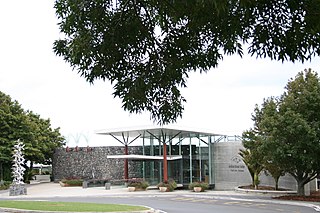
Auckland Botanic Gardens is a botanical garden in the New Zealand city of Auckland. It is located in the suburb of Manurewa, in the Manurewa Local Board Area. The garden covers 64 hectares, and holds more than 10,000 plants.
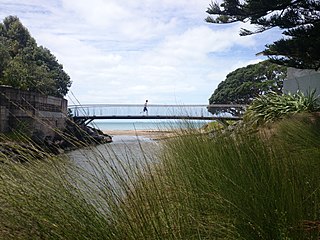
Campbells Bay is a suburb of the North Shore located in Auckland, New Zealand.
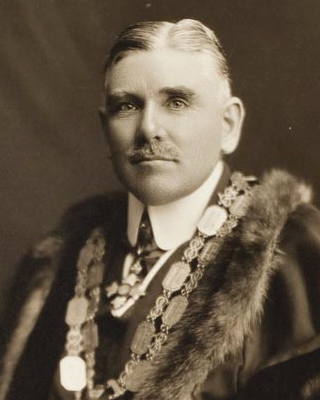
Sir James Henry Gunson was a New Zealand businessman and Mayor of Auckland City from 1915 to 1925. He was knighted in 1924.

Greenwoods Corner is an Auckland neighbourhood located within the suburb of Epsom, situated to the south of Newmarket and to the north of Royal Oak, at the intersection of Pah Road and Manukau Road. It is settled in the lee of Maungakiekie / One Tree Hill and serves as a convenient launching point for the area's many attractions.

Israel Joseph Goldstine was mayor of One Tree Hill, New Zealand, from 1931 until he retired in 1947. He was a prominent barrister and solicitor in Auckland and chaired several high-profile New Zealand boards.
One Tree Hill is a suburb of Auckland, New Zealand. The residential part of the suburb is located to the east and south-east of Maungakiekie / One Tree Hill, from which it takes its name, with the volcanic peak located within the suburb's boundaries.

Cornwall Hospital was constructed in Cornwall Park, Auckland, New Zealand during World War II by the American Army and was named the 39th United States General Hospital. It accommodated casualties from the war in the Pacific. From 1945 it was leased by the Auckland Hospital Board to provide maternity and geriatric services and closed in 1975.
The 1938 Auckland Rugby League season was its 30th. Marist Old Boys won their 3rd first grade title with their previous coming in 1924 and 1931.

Mutukāroa / Hamlins Hill Regional Park is a regional park situated in the Auckland suburb of Penrose in New Zealand's North Island. It is situated in Maungakiekie-Tāmaki, north-east of the Manukau Harbour and west of the Tāmaki River. The park is owned and operated by Auckland Council.
Kiwi Tāmaki was a Māori warrior and paramount chief of the Waiohua confederation in Tāmaki Makaurau. The third generation paramount chief of Waiohua, Kiwi Tāmaki consolidated and extended Waiohua power over Tāmaki Makaurau, making it one of the most prosperous and populated areas of Aotearoa. Kiwi Tāmaki's seat of power was at Maungakiekie, which was the most elaborate pā complex in Aotearoa.

Greenlane Clinical Centre is a public hospital in Greenlane, Auckland, located on Green Lane West, near Cornwall Park. The hospital is administered by the Northern division of Te Whatu Ora providing outpatient and day surgery services to the Auckland Region. The healthcare facilities at Greenlane have seen many notable developments in New Zealand's healthcare.

Monte Cecilia Park is located in the Auckland suburb of Hillsborough, close to its boundary with Royal Oak. The park's landscape showcases a diverse variety of mature exotic plants as well as native New Zealand flora.

